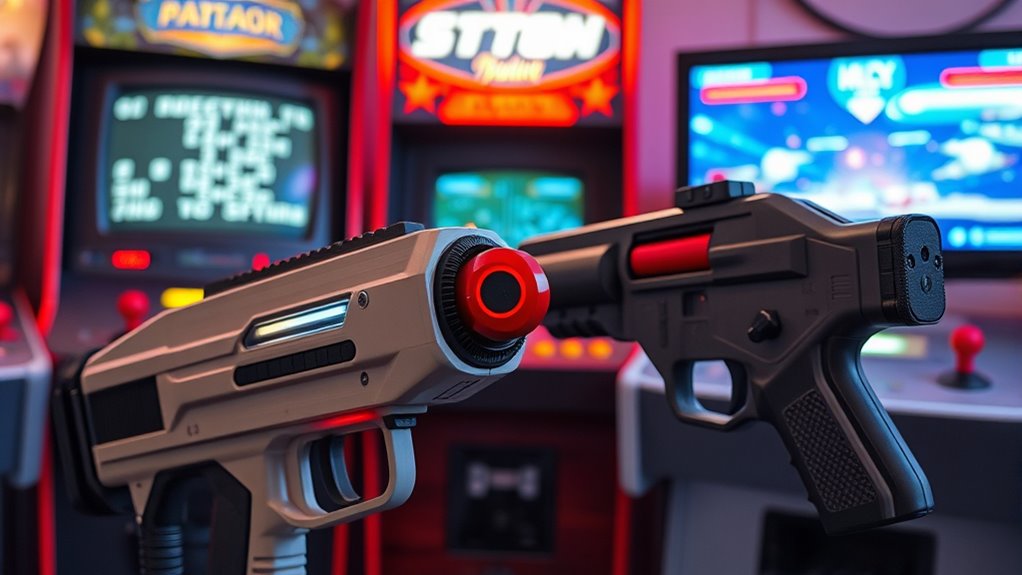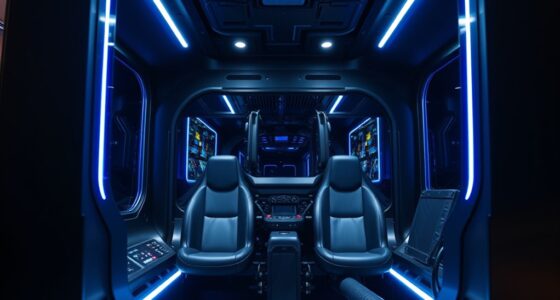The evolution of light-gun technology in arcades has progressed from early optical and mechanical systems to advanced infrared and laser-based guns for precise targeting. Innovations like motion sensors and accelerometers made gameplay more responsive, while digital displays and LCD screens enhanced visuals and immersion. Future trends point towards augmented reality and wireless guns that promise even more realistic experiences. To discover how these developments shaped arcade gaming, explore the full history and innovations behind these systems.
Key Takeaways
- Early light-guns used optical sensors and mechanical triggers, establishing foundational gameplay mechanics in arcades.
- Advancements in optical detection and signal processing improved accuracy and responsiveness of modern light-gun systems.
- Infrared and laser-based guns offered precise targeting and reduced false triggers, becoming industry standards.
- Integration of motion sensors and accelerometers enabled natural interactions and enhanced player immersion.
- Future developments focus on augmented reality, wireless controls, and haptic feedback, further transforming arcade light-gun experiences.
The Dawn of Light-Gun Gaming: Early Optical and Mechanical Systems
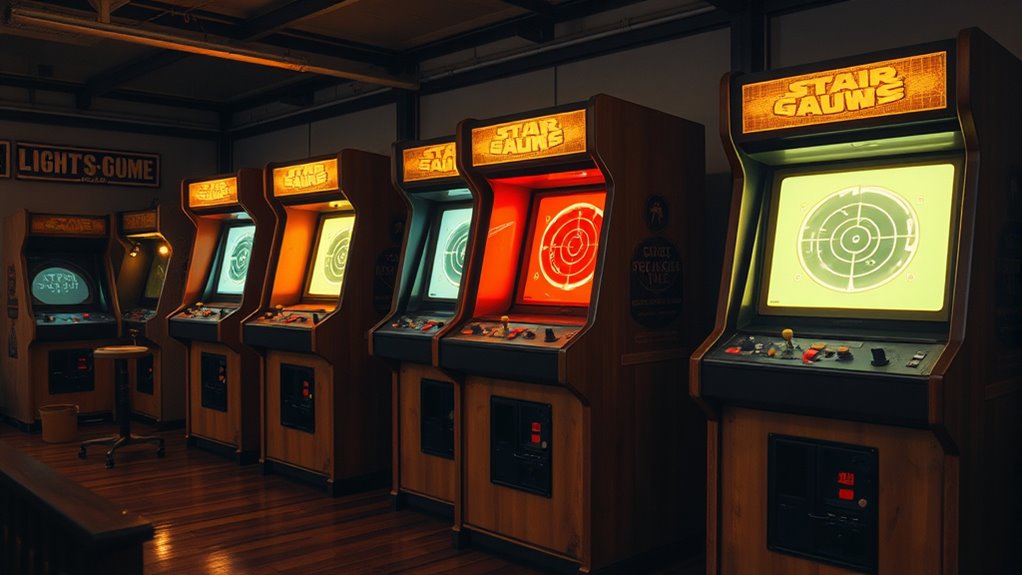
Although early light-gun systems laid the groundwork for interactive gaming, they relied heavily on optical and mechanical technologies that were both innovative and limited. In the historical context, these systems marked a significant leap from traditional arcade games by introducing user interaction through targeting. Hardware innovations played a vital role, such as sensors and mechanical triggers that detected when you pulled the trigger or aimed at the screen. These early systems used optical sensors to register hits, offering a more immersive experience compared to static gameplay. Despite their simplicity, these innovations paved the way for more sophisticated technology. They demonstrated that integrating hardware improvements could create engaging, responsive gameplay, setting the stage for future advancements in light-gun technology. Additionally, understanding Grocery Savings Strategies can help arcade venues and game developers optimize their budgets for hardware upgrades and maintenance.
Advancements in Optical Detection and Signal Processing
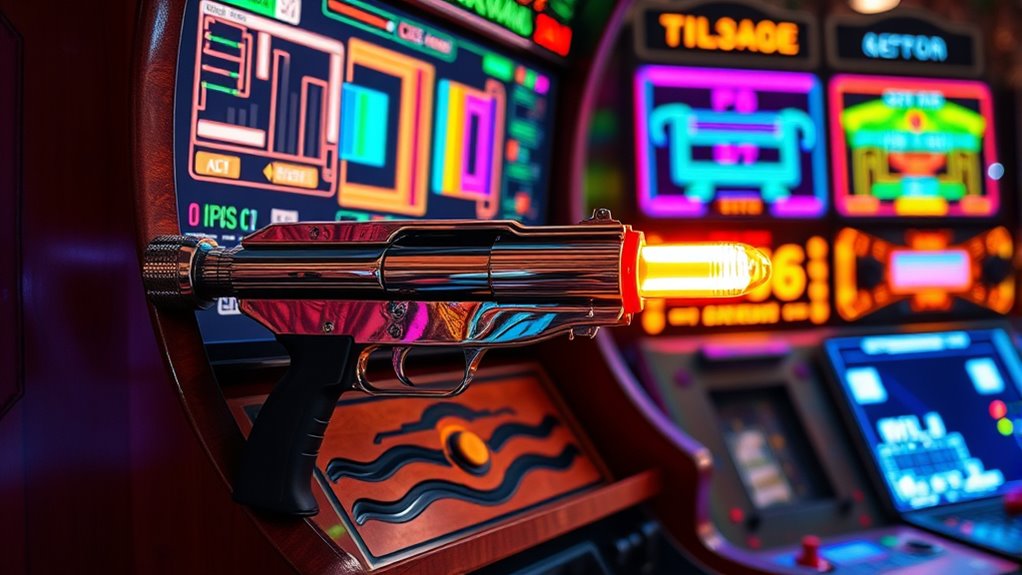
Recent advancements in optical detection and signal processing have considerably enhanced the accuracy and responsiveness of light-gun systems. Modern sensors now undergo precise calibration, ensuring they accurately interpret the gun’s position and target hits. Signal filtering techniques play a *vital* role by removing noise and minimizing false detections, which improves overall reliability. These improvements allow the system to quickly and accurately detect the gun’s aim, even in challenging lighting conditions. Developers also refine algorithms to better distinguish intentional shots from background disturbances. As a result, gameplay becomes more seamless and immersive, with faster response times and fewer errors. Additionally, understanding and addressing AI security vulnerabilities can help improve the robustness of these systems against malicious interference. These technological leaps set the stage for more sophisticated and precise light-gun experiences, paving the way for future innovations in arcade gaming.
The Rise of Infrared and Laser-Based Light Guns
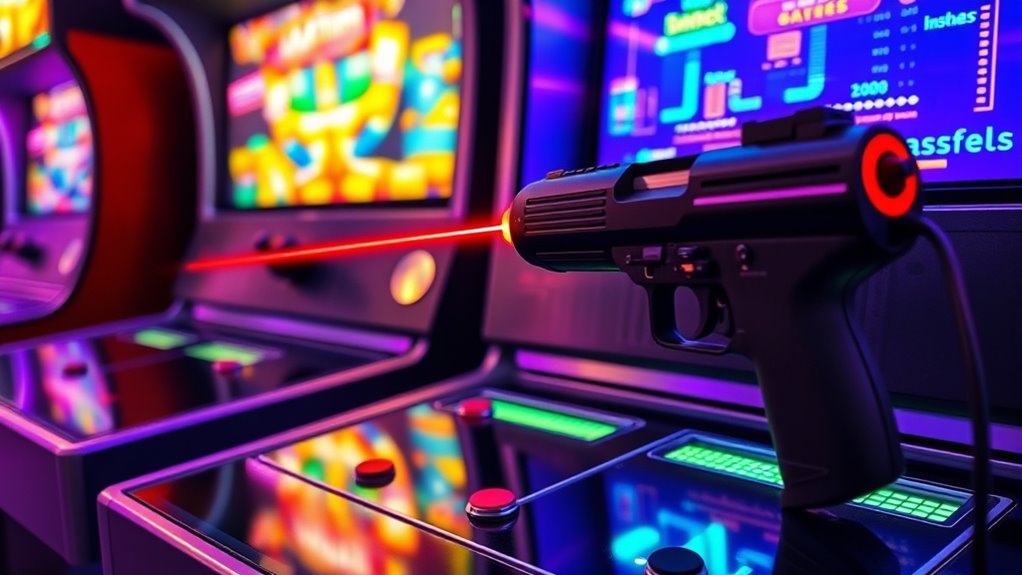
Building on advancements in optical detection, infrared and laser-based light guns have emerged as powerful alternatives that offer improved targeting accuracy and reliability. Infrared sensors detect the precise position of the gun relative to the screen, reducing false triggers caused by ambient light. Laser-based systems enhance laser accuracy, allowing for pinpoint targeting even at greater distances. These technologies provide more consistent performance in arcade environments, minimizing misfires and improving user experience. Infrared sensors enable quick calibration and better tracking, making gameplay smoother. The combination of laser precision and infrared detection elevates light-gun technology beyond traditional methods, ensuring a more immersive and responsive experience for players. As a result, infrared and laser-based light guns have become the standard for modern arcade shooting games.
Integration of Motion Sensors and Accelerometers
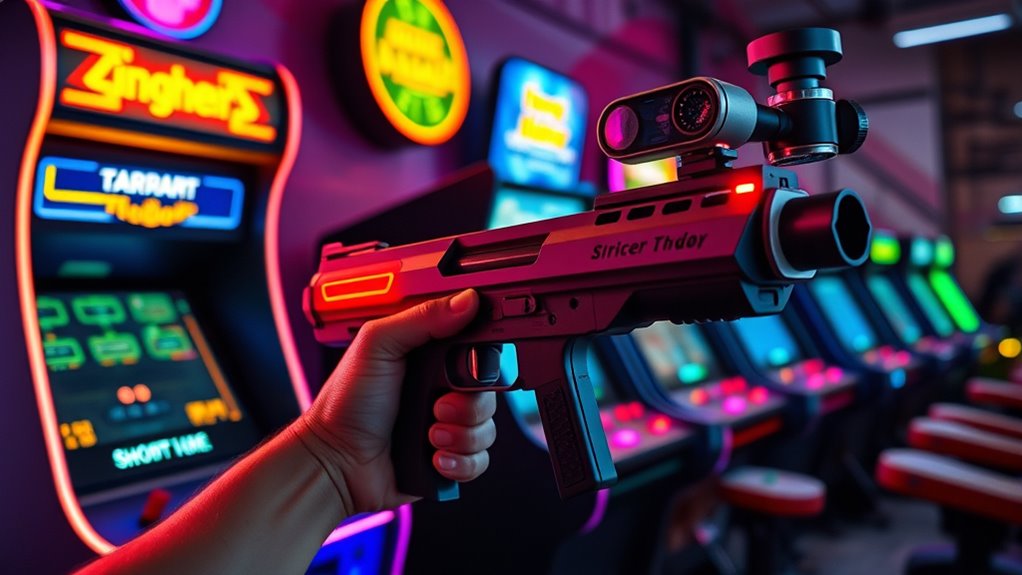
By integrating motion sensors and accelerometers, light guns can now detect even subtle movements with accuracy. This technology allows for enhanced motion detection, making gameplay more responsive and immersive. As a result, you get precise player tracking that improves overall interaction and realism. Paint sprayer technology has also seen similar advancements, emphasizing precision and efficiency in application.
Enhanced Motion Detection
The integration of motion sensors and accelerometers has considerably advanced light-gun technology by enabling more accurate and responsive detection of player movements. This improvement relies on proper sensor calibration to guarantee consistent performance and minimize errors. Calibration adjusts for individual player handling, making the system more precise. Additionally, developers work to reduce ambient interference, such as lighting conditions or electromagnetic noise, which can disrupt sensor signals. By refining sensor calibration and controlling environmental factors, the system responds more reliably to quick, subtle motions. Implementing noise reduction techniques further enhances the accuracy of sensor data, making gameplay smoother. This enhanced motion detection creates a more immersive gaming experience, allowing players to interact naturally without frustration from lag or misinterpretation. Overall, these advancements mark a significant step toward more sophisticated, intuitive light-gun interfaces in arcade gaming.
Precise Player Tracking
Advancements in motion sensors and accelerometers have enabled light-gun systems to achieve highly precise player tracking. This technology allows for accurate gesture recognition, making gameplay more responsive and immersive. Proper sensor calibration is essential to eliminate drift and guarantee consistent performance. With precise tracking, your movements translate seamlessly into onscreen actions, reducing latency and increasing accuracy. The integration of these sensors also enables complex gestures, adding new layers of interaction. Below is a table illustrating key benefits:
| Benefit | Impact |
|---|---|
| Gesture Recognition | Enhances player interaction and realism |
| Sensor Calibration | Ensures consistent accuracy |
| Precise Tracking | Improves gameplay responsiveness |
Furthermore, sensor reliability plays a crucial role in maintaining long-term performance and user satisfaction.
The Influence of Digital Technology and LCD Displays
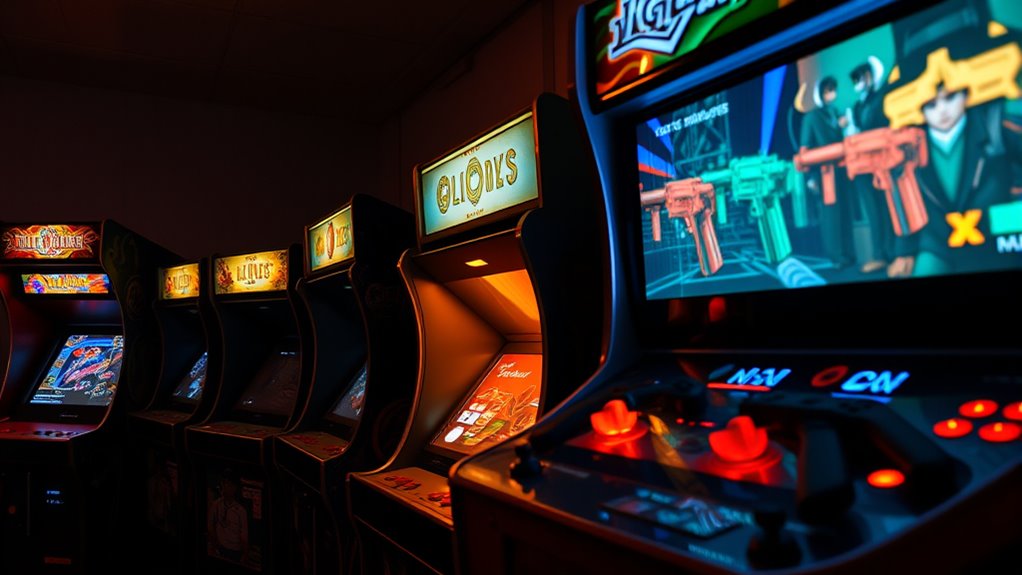
Digital technology has revolutionized light-gun systems, making them more immersive and responsive than ever before. LCD displays provide bright, sharp visuals that heighten realism, pulling you into the game. With sound synchronization, audio cues align perfectly with on-screen actions, enhancing your sense of presence. Haptic feedback adds a tactile layer, letting you feel impacts or gunfire vibrations, which boosts immersion. These advancements eliminate lag and improve accuracy, creating a seamless gaming experience. You now enjoy quicker response times and more precise targeting, making arcade shooters more engaging. Additionally, Kia Tuning techniques have contributed to the development of more precise sensor systems that enhance tracking accuracy. As digital technology progresses, light-gun systems deliver a more lifelike feel, combining visual, auditory, and tactile elements to transform how you interact with arcade games.
Future Trends: Augmented Reality and Wireless Light-Guns
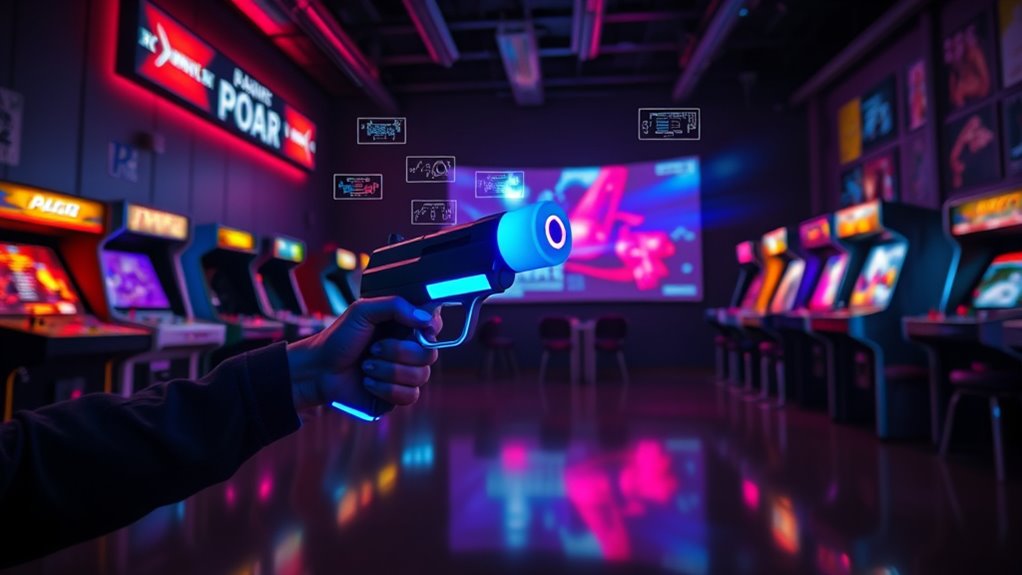
How will augmented reality and wireless technology shape the future of light-gun gaming? You’ll see a more immersive experience blending virtual reality with real-world actions. Wireless light-guns eliminate cords, giving you greater freedom to move and react naturally. Expect these advancements to include:
- Enhanced realism through integrated haptic feedback, making shots feel more authentic.
- Virtual reality headsets combining with AR to create seamless, mixed-reality environments.
- Precise motion tracking for accurate aiming, even in complex virtual scenarios.
- Increased accessibility, allowing players to enjoy arcade-style gameplay anywhere, anytime.
- Ongoing innovations in hardware development will continue to improve performance and user experience.
These innovations will transform traditional light-gun games into dynamic, sensory-rich experiences, pushing arcade entertainment into a new era of interactivity and realism.
Frequently Asked Questions
How Did Early Light-Gun Systems Influence Modern Gaming Ergonomics?
Early light-gun systems shaped modern gaming by emphasizing gun ergonomics and player comfort. You notice how these designs prioritized ease of holding and aiming, making gameplay more intuitive. As technology advanced, manufacturers refined gun ergonomics to reduce fatigue and improve precision, ensuring players stay comfortable during extended sessions. This focus on ergonomic design influences current controllers and aiming devices, making your gaming experience more natural and enjoyable.
What Were the Main Challenges in Developing Infrared and Laser Light Guns?
When developing infrared and laser light guns, you faced key challenges like infrared calibration, ensuring the sensors accurately detect your aim without drift. You also had to address laser safety concerns, preventing eye injuries while maintaining precise targeting. Balancing these technical hurdles was essential to creating devices that are both safe and reliable, ultimately leading to more immersive and accurate gaming experiences.
How Do Motion Sensors Improve Light-Gun Accuracy and Gameplay Experience?
Motion sensors improve your light-gun experience by enhancing accuracy through better sensor calibration and precise motion detection. They track your hand movements more reliably, reducing misfires and making gameplay smoother. As you aim, the sensors quickly interpret your gestures, providing a more realistic and immersive experience. This technology minimizes lag, ensuring your shots register correctly and boosting overall enjoyment, making each gaming session more engaging.
What Role Did Digital Displays Play in Advancing Light-Gun Technology?
Digital displays acted as the canvas upon which light-gun technology painted its greatest strokes. They revolutionized gaming by integrating digital display innovations, allowing for sharper visuals and more precise targeting. These advancements enhanced visual feedback mechanisms, making gameplay more immersive and responsive. As a result, players experienced a new level of realism, turning simple shooting games into engaging, high-tech battles where every shot felt more impactful and visually satisfying.
How Might Augmented Reality Redefine Future Light-Gun Gaming Experiences?
Augmented reality can transform your light-gun gaming by blending virtual overlays with real-world environments. Using spatial mapping, you’ll experience immersive gameplay where your surroundings become part of the game. This technology allows your light gun to interact more intuitively with virtual objects, creating a more realistic and engaging experience. As AR advances, expect future games to offer seamless integration of virtual and physical worlds, making gameplay more dynamic and personalized.
Conclusion
As you’ve seen, light-gun technology has evolved like a river carving new paths through gaming history. From simple mechanical sights to sleek infrared and laser systems, each breakthrough brightened the arcade landscape. Looking ahead, augmented reality and wireless guns promise to transform your gaming experience even further, like opening a window to a new universe. The future of light-guns is a thrilling journey waiting for you to explore, full of innovation just beyond the horizon.
